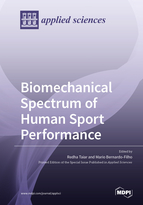Biomechanical Spectrum of Human Sport Performance
A special issue of Applied Sciences (ISSN 2076-3417). This special issue belongs to the section "Applied Biosciences and Bioengineering".
Deadline for manuscript submissions: closed (31 December 2019) | Viewed by 171963
Special Issue Editors
Interests: biomechanics of health disease and rehabilitation; industry engineering for medicine and high-level sport
Special Issues, Collections and Topics in MDPI journals
Interests: sport; health; disease; rehabilitation
Special Issues, Collections and Topics in MDPI journals
Special Issue Information
Dear Colleagues,
Our health and wellbeing are influenced by a range of social, cultural, economic, psychological, and environmental factors across our lives. Sport can be a vector that links many of these factors. Whether it is high-performance sport or sedentary practice, sport is very important for the improvement of the psychological well being and physical health. Our overarching aim is to increase quality of life. Sedentary practice can increase mobility and reduce the risk of disease, so changing adults’ behavior through sendentary practice could reduce illness and decrease costs to society concerning health problems. Furthermore, a higher frequency of practice can lead to improvements in technique, and optimized performance. Our objective is to summarize the most important biomechanical parameters influencing human performance related to the health sciences for all age groups, throughout their lives.
Prof. Redha TAIAR
Prof. Mario Bernardo-Filho
Guest Editors
Manuscript Submission Information
Manuscripts should be submitted online at www.mdpi.com by registering and logging in to this website. Once you are registered, click here to go to the submission form. Manuscripts can be submitted until the deadline. All submissions that pass pre-check are peer-reviewed. Accepted papers will be published continuously in the journal (as soon as accepted) and will be listed together on the special issue website. Research articles, review articles as well as short communications are invited. For planned papers, a title and short abstract (about 100 words) can be sent to the Editorial Office for announcement on this website.
Submitted manuscripts should not have been published previously, nor be under consideration for publication elsewhere (except conference proceedings papers). All manuscripts are thoroughly refereed through a single-blind peer-review process. A guide for authors and other relevant information for submission of manuscripts is available on the Instructions for Authors page. Applied Sciences is an international peer-reviewed open access semimonthly journal published by MDPI.
Please visit the Instructions for Authors page before submitting a manuscript. The Article Processing Charge (APC) for publication in this open access journal is 2400 CHF (Swiss Francs). Submitted papers should be well formatted and use good English. Authors may use MDPI's English editing service prior to publication or during author revisions.
Keywords
- injury prevention and rehabilitation
- training, strength and conditioning
- exercise
- coaching
- teaching
- equipment
- modelization and simulation
- measurement acquisitions and techniques
- human wellbeing
- quality of life
Benefits of Publishing in a Special Issue
- Ease of navigation: Grouping papers by topic helps scholars navigate broad scope journals more efficiently.
- Greater discoverability: Special Issues support the reach and impact of scientific research. Articles in Special Issues are more discoverable and cited more frequently.
- Expansion of research network: Special Issues facilitate connections among authors, fostering scientific collaborations.
- External promotion: Articles in Special Issues are often promoted through the journal's social media, increasing their visibility.
- Reprint: MDPI Books provides the opportunity to republish successful Special Issues in book format, both online and in print.
Further information on MDPI's Special Issue policies can be found here.







